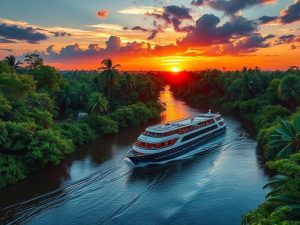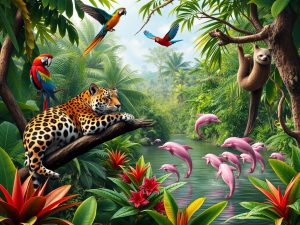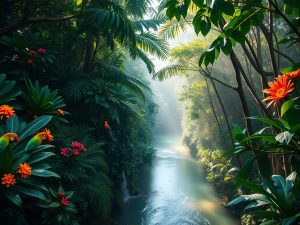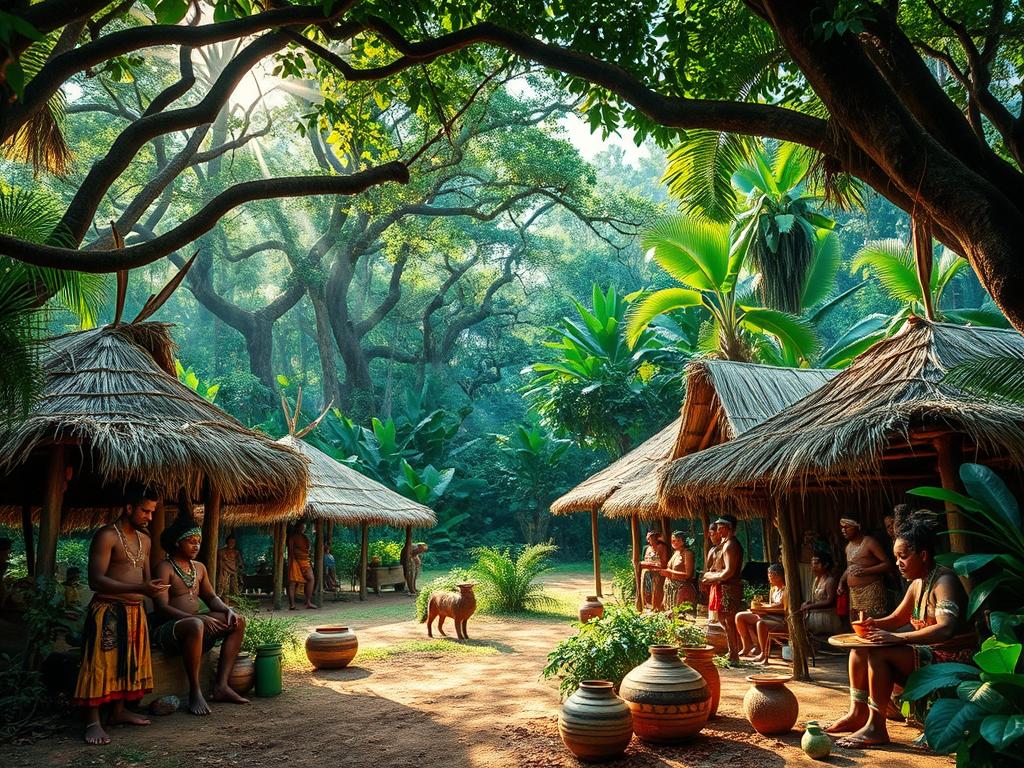
The Amazon rainforest is a vast, mystical area in South America. It’s home to many indigenous tribes. Each tribe has its own language, customs, and traditions. They have lived here for thousands of years, creating a rich cultural heritage.
This exploration takes us into the lives of these people. It offers a glimpse into the Amazon’s complex world.
Indigenous tribes in the Amazon live in harmony with the land. They use the Amazon’s waterways for food and travel. Their knowledge of nature has helped them survive and thrive.
This knowledge shows how to live sustainably. It’s a lesson for us all.
We will learn about the Amazon’s diverse tribes. We’ll see their customs, beliefs, and the challenges they face today. Join us as we celebrate their strength and resilience. Their survival depends on protecting the Amazon’s ecosystems.
Who are the Indigenous Peoples of the Amazon?
The Amazon rainforest is home to many indigenous peoples. Each group has its own culture and way of life. They have lived here for thousands of years, deeply connected to the land and its resources.
Defining Indigenous Peoples
There are thousands of ethnic groups in tropical rainforests, like the Amazon. The Rainforest Action Network says these groups have their own languages and cultures. They live differently, using the forest for food, medicine, and clothes.
Diversity of Ethnic Groups and Cultures
The diversity of indigenous groups in the Amazon is amazing. Each community is unique, like the Yanomami and Tikúna. Their cultural diversity shows their resilience and adaptability.
| Indigenous Tribe | Population | Location | Key Characteristics |
|---|---|---|---|
| Yanomami | 27,000 | Brazil and Venezuela | Hunter-gatherers, live in communal houses, use of hallucinogens in rituals |
| Tikúna | 46,000 | Brazil, Colombia, Peru | Horticulturists, use of natural dyes and weaving, oral storytelling traditions |
| Kayapó | 9,000 | Brazil | Skilled in forest management, practice sustainable agriculture, fight against deforestation |
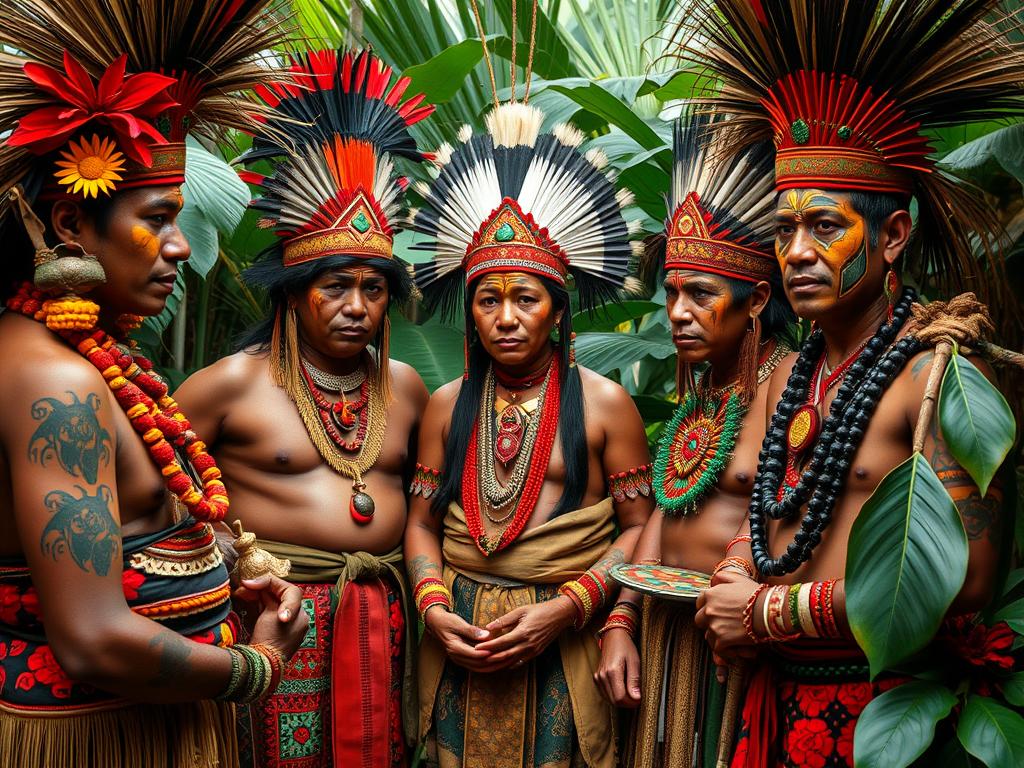
Despite challenges, indigenous communities in the Amazon keep their traditions alive. They face many obstacles but continue to preserve their unique way of life.
Traditional Ways of Living
The indigenous peoples of the Amazon have lived in harmony with the rainforest for thousands of years. They practice a sustainable existence that shows deep respect for nature. The Rainforest Action Network says these communities live differently, using the forest for food, medicine, and clothes.
They use traditional farming methods like shifting cultivation. This method lets the land recover over time. It’s a sustainable approach that contrasts with the recent threats to the Amazon.
Sustainable Existence and Reverence for the Forest
Indigenous Amazonians see the forest as a provider and protector. They call it the “mother of our races.” This deep spiritual bond with the land is key to their traditional way of life.
Dr. John Hemming, an expert on the Amazon, has studied indigenous tribes and their respect for nature. He has written over two dozen books, including a three-volume history of indigenous exploration in the region.
“The indigenous peoples of the Amazon organize their daily lives differently than our culture, relying on the forest for their food, medicine, and clothing.”
However, their traditional ways of living face growing threats. The Amazon rainforest is facing deforestation and exploitation. Rieli Franciscato, a forest indigenous expert, was tragically killed while protecting indigenous rights in the Amazon.
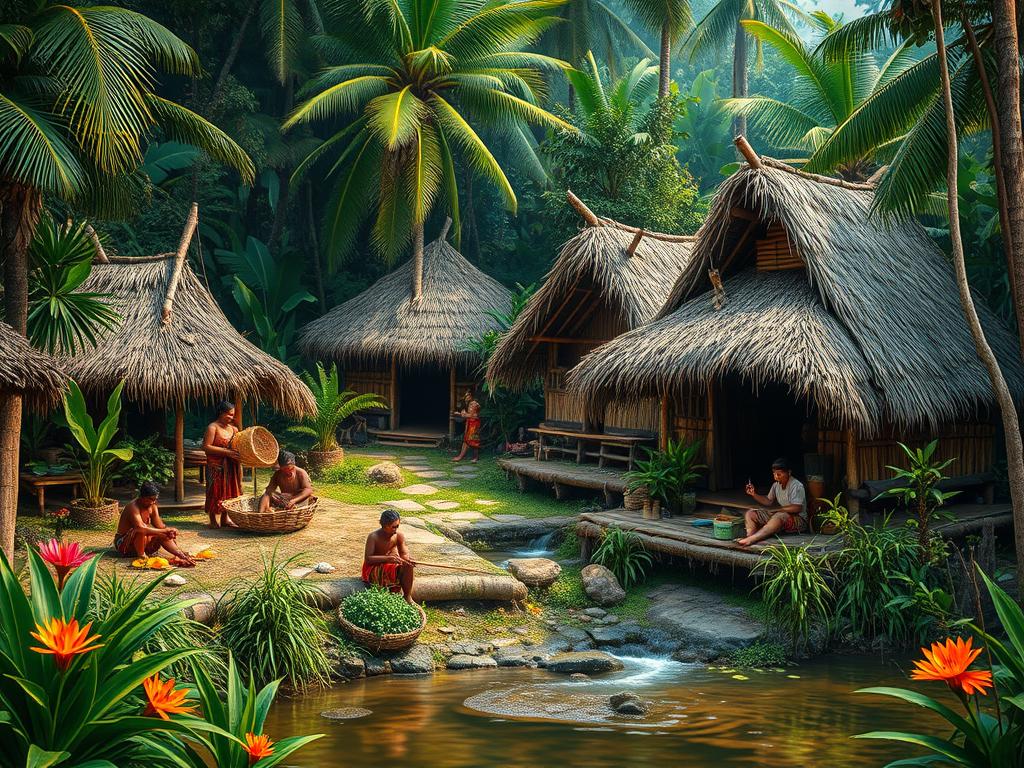
Despite these challenges, indigenous tribes in the Amazon still show great respect for nature. Their sustainable way of living teaches us important lessons. It shows us how to live in harmony with the environment.
The Indigenous Tribes of the Amazon: A Cultural Exploration
The Amazon rainforest is home to many indigenous cultures. Each has its own traditions, beliefs, and way of life. These tribes have lived in harmony with the forest for thousands of years.
Exploring their culture, we learn about their deep connection with nature. They farm sustainably and respect the land. Their ways of life contrast sharply with modern culture, showing us the value of preserving traditional knowledge.
The Amazon and its people are closely tied. Threats like deforestation and climate change are growing. Saving their cultures and knowledge is key to protecting the forest.
| Indigenous Groups | Population | Traditional Practices |
|---|---|---|
| Yanomami | 35,000 | Shifting cultivation, hunting, fishing, and gathering |
| Kayapó | 9,000 | Sustainable farming, forest management, and artisanal crafts |
| Munduruku | 14,000 | Subsistence farming, fishing, and the preservation of oral traditions |
“The Amazon is our home, our life. We are part of this forest, and the forest is part of us. To protect the Amazon is to protect our very existence.”
The indigenous tribes of the Amazon are resilient and adaptable. Despite threats, they protect the forest. Their knowledge and practices are vital for the ecosystem’s balance.
Learning from Indigenous Knowledge
The indigenous peoples of the Amazon have a vast wealth of traditional ecological knowledge. This knowledge includes skills in hunting, fishing, and farming. It also includes understanding the forest’s plants, animals, and medicines. Children learn these skills from their parents and elders, living in the rainforest’s rhythms.
As the Rainforest Action Network notes, many Amazonian children “know more about rainforests than scientists who have studied rainforests for many years!” This generational transmission of knowledge is key to the survival and preservation of indigenous cultures in the Amazon.
Passing Down Knowledge through Generations
The Amazoniar project aims to connect the Amazon with the world. It promotes a global dialogue on the Amazon forest and its impact. The third cycle of Amazoniar will have four webinars from September to October, focusing on the culture and art of Amazon indigenous peoples.
Paulo Moutinho, a senior researcher at IPAM, will moderate the webinars. He stresses the need to preserve indigenous cultural wealth and their rights to their land. Interpretation into English will be provided for all live-streamed meetings via Zoom, reaching a wider audience.
“Indigenous cultures in the Amazon region hold an extensive knowledge that is transmitted through art and culture to raise awareness about important issues affecting the Amazon and its population.”
The meetings will cover various themes. These include breaking stereotypes about Amazon’s indigenous peoples and exploring indigenous literature and legends. They will also feature traditional and current songs of indigenous peoples and the perspective of traditional peoples through photography and audiovisual content.
The book “Traditional Ecological Knowledge: Learning from Indigenous Practices for Environmental Sustainability” shows the deep connection between biological and cultural diversity. It highlights the importance of Indigenous Elders’ perspectives in solving climate change. Elders focus on inclusivity, social cohesion, and the interconnectedness of humans.
Threats to Indigenous Peoples
The indigenous communities of the Amazon rainforest have faced many threats since European colonizers arrived. Diseases, losing their land, and using up resources have harmed these ancient cultures a lot.
Impact of European Colonization
The first European explorers brought diseases like smallpox and measles. These diseases killed over 90% of native peoples, almost wiping out many Amazonian tribes. Settlers also took over their lands, pushing communities away from their traditional homes and resources.
Loss of Land and Resources
Roads, mining, and farming have led to the loss of indigenous lands and the Amazon rainforest. This has hurt many Amazonian tribes, showing how vulnerable they are to outside forces.
| Threat | Impact |
|---|---|
| Deforestation | By 2019, about 20% of the Brazilian Amazon was lost, threatening the lives and resources of indigenous communities. |
| Illegal Mining | New laws could let mining in up to 15% of indigenous lands, exposing them to mercury, disease, and losing biodiversity. |
| Violence and Conflict | In 2019, there was a 134% rise in invasions, illegal use, and damage to indigenous lands, with 113 murders of indigenous people. |
The threats to indigenous Amazonian communities are urgent. We must protect their land rights and traditional ways of life. Saving the Amazon’s culture and environment is key to their survival.
Indigenous Resistance and Advocacy
Indigenous Amazonian communities have always fought against outsiders. They have a long history of resisting and defending their lands. The Rainforest Action Network says many groups have peacefully protested, even risking arrest or death. Their efforts show their strong will to protect their homes and traditions.
Indigenous advocates are now working with global groups to fight for their rights. They aim to protect their lands and the Amazon rainforest. This fight is key to keeping their cultures alive against outside threats.
“The song ‘Enough!’ composed by Iãkupa Apurinã addresses pressing issues faced by indigenous peoples worldwide. The reference to urucum, a natural pigment, symbolizes the indigenous identity deeply ingrained in the land. The song highlights the urgency of addressing critical issues such as deforestation and environmental degradation.”
Indigenous women have been crucial in defending their communities. Denilson Baniwa, an indigenous artist from Brazil, uses his art to speak out against violence. In Brazil’s Mato Grosso do Sul, 14 Guarani Kaiowá leaders were killed trying to protect their lands.
The Amazon Symposium 2019 brought together artists like Denilson Baniwa and Djuena Tikuna. Djuena Tikuna, from the Tikuna tribe, performed at the Teatro Amazonas in Manaus. Her songs and dances showed her dedication to preserving her culture and language.
Preserving Indigenous Cultures
The Amazon is facing big threats from development and outsiders. It’s urgent to save indigenous cultures. Sustainable tourism and ecotourism can help support these communities while respecting their ways.
Jared Sternberg, the Gondwana founder, says some Amazonian tribes welcome visitors. They share their culture and traditions. This can help them economically while teaching travelers about Amazonian cultural preservation.
Sustainable Tourism and Ecotourism
Ecotourism focuses on cultural preservation, fair sharing, and protecting the environment. It’s key to keeping indigenous ways of life alive. Studies show indigenous lands and conservation areas do well in forest health.
Also, giving indigenous forestland back can cut down deforestation. This avoids a lot of CO2 emissions every year. By letting indigenous peoples care for their lands, we protect the Amazon and their culture.
“Regaining land title and authority over their lands has health benefits for indigenous peoples, aligning with indicators of material, social, and spiritual/cultural wellbeing.”
Connections Between the Andes and the Amazon
The Andes mountains and the Amazon rainforest are closely linked. They share a rich history and deep cultural ties. These ties were shaped by the movement and interactions of indigenous groups across their diverse landscapes.
Historical and Cultural Ties
The Amazon Assessment Report 2021 talks about the long-standing ties between the Andes and the Amazon. It mentions extensive trade networks, shared knowledge, and cultural exchanges. Indigenous communities have crossed the highlands and lowlands, keeping strong historical connections and cultural ties.
- The Quechua-speaking people of the Andes have long-standing connections with the indigenous groups of the Amazon, trading goods and sharing cultural practices.
- Archaeological evidence suggests that ancient Andean civilizations, such as the Inca Empire, had significant influence and interactions with Amazonian societies.
- Even today, many indigenous communities in the Amazon maintain links with their Andean counterparts, preserving traditional knowledge and customs across regional boundaries.
But, colonial borders and the marginalization of indigenous peoples have disrupted these connections. Still, the legacies of these deep historical and cultural ties are seen in the Amazon basin’s diverse culture.
“The Amazon and the Andes are inextricably linked, both geographically and culturally. Their shared history is one of resilience, exchange, and the enduring spirit of indigenous peoples who have traversed these landscapes for millennia.”
Myths and Legends of the Amazon
The Amazon rainforest has long fascinated people outside its borders. It has inspired many Amazon myths and Amazon legends. The Amazon River and its area got their names from European myths and dreams.
These stories have made the Amazon seem mysterious and alluring. They have helped shape the Amazon’s image as a place full of natural wonders and danger.
Indigenous storytelling and Amazonian folklore have also played a big role. They offer unique views on the world, spiritual realms, and human life in this vast landscape. Tales like the Boto and the Iara are part of the Amazon’s cultural legacy.
The Amazon is home to many legends, like the Caiman Man and the story of Orellana. These stories are not just fun tales. They also show the rich traditions of the indigenous peoples who live there.
“The true nature of the Amazon is experienced through activities like traveling in a dugout canoe through flooded forests, sleeping in hammocks amidst the forest, waking up to howler monkeys’ cries, and discovering Amerindian traditions.”
As the world faces challenges in the Amazon, saving these stories is key. They give us a glimpse into the past and help us understand the bond between people and their land.
Colonial Legacies and Borders
The history of European colonization in the Amazon has deeply affected the region. It has shaped political, social, and cultural relations. From the 16th to the 18th centuries, borders were set up between European kingdoms and the states that followed.
These borders often ignored the long-standing interactions between indigenous groups. They also overlooked the exchanges between the Andes and the Amazon.
The colonial conquest era was driven by greed and a desire for control. Explorers sought gold and established settlements. They also brought slavery and imposed their own institutions.
Indigenous peoples faced violence and resistance against the colonizers. This led to the creation of new identities, with some seen as “civilized” and others as “barbarians.”
Technologies like iron tools introduced new tensions. Today, cities in the Amazon reflect the lasting impact of colonial legacies.
Artificial borders and colonial legacies still affect the Amazon today. The Amazon Assessment Report 2021 shows how colonial legacies, borders, and Andes-Amazon relations shape the region’s future.
“The relationship between Indigenous peoples and European conquerors was often violent, resulting in Indigenous resistance against military and religious control expansion.”
Conclusion
The indigenous cultures of the Amazon rainforest have a deep heritage. They have lived in harmony with nature for centuries. But, colonization and modernization have changed their lives.
This article has shown how diverse their ways of living are. It also highlighted their traditional knowledge and ongoing struggles. It’s clear that saving their cultures and ways of life is crucial.
The Amazon is facing big threats like resource extraction and land loss. It’s urgent to support and empower indigenous communities. Sustainable tourism and understanding their history can help.
There’s hope for a future where their knowledge helps protect the Amazon. This region is unique and needs their care.
The Amazon’s indigenous cultures show human resilience in tough times. We must recognize and respect their rights. This way, we can save their knowledge, traditions, and the Amazon’s ecosystem.
Working together, we can protect the Amazon rainforest and its cultures. This is a shared responsibility for indigenous peoples, governments, and the world.

